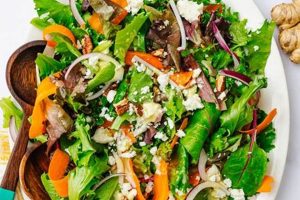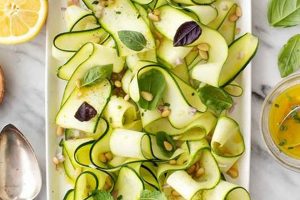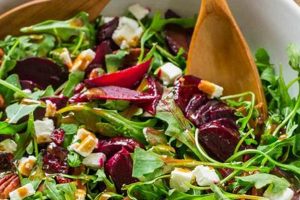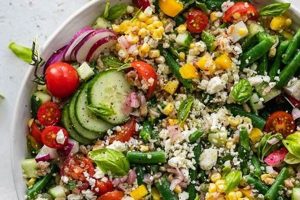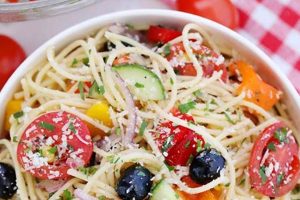A dish featuring flaked, cured salmon as the primary ingredient, typically combined with complementary elements like cream cheese, mayonnaise, herbs, and vegetables. Variations can include additions such as capers, red onion, lemon juice, or dill. These salads are frequently served chilled on bread, crackers, or as a light meal on their own.
This culinary creation offers a balance of rich flavor and nutritional value. Salmon provides omega-3 fatty acids and protein, while the accompanying ingredients contribute vitamins, minerals, and textural variety. Its adaptability makes it suitable for various occasions, from casual lunches to elegant appetizers. Historically, preserved fish salads have been enjoyed for centuries, reflecting resourcefulness and culinary ingenuity across different cultures.
The subsequent sections will explore various aspects of preparing and enjoying this versatile dish, including recommended ingredient combinations, step-by-step preparation instructions, and serving suggestions.
Tips for Crafting an Exceptional Salmon Salad
Optimizing ingredient selection and preparation techniques enhances the overall quality and enjoyment of this versatile dish. Attention to detail ensures a flavorful and visually appealing result.
Tip 1: Quality Salmon Selection: Opting for high-quality, cold-smoked salmon is paramount. Look for vibrant color and a firm texture, avoiding any signs of discoloration or dryness.
Tip 2: Proper Flaking Technique: Gently flake the salmon into bite-sized pieces, taking care not to over-shred, which can result in a mushy texture.
Tip 3: Balancing Flavor Profiles: The supporting ingredients should complement, not overpower, the salmon’s delicate flavor. A judicious use of herbs, spices, and acidic elements like lemon juice or capers achieves this balance.
Tip 4: Cream Cheese and Mayonnaise Ratio: Achieving the desired creaminess requires careful consideration of the cream cheese to mayonnaise ratio. A higher proportion of cream cheese yields a richer, denser salad, while more mayonnaise results in a lighter consistency.
Tip 5: Fresh Herb Incorporation: Freshly chopped herbs, such as dill, chives, or parsley, elevate the flavor profile significantly. Adding these just before serving preserves their vibrancy.
Tip 6: Chill Time Enhancement: Allowing the salad to chill for at least 30 minutes before serving allows the flavors to meld and enhances the overall experience.
Tip 7: Serving Suggestions: Consider serving the salad on crusty bread, crackers, cucumber slices, or endive leaves for an elegant presentation.
By adhering to these guidelines, one can consistently create a salmon salad that is both delicious and visually appealing. The careful combination of quality ingredients and thoughtful preparation techniques yields optimal results.
In conclusion, crafting a truly exceptional salmon salad involves focusing on the nuances of flavor and texture, ensuring a delightful culinary experience.
1. High-quality Smoked Salmon
High-quality smoked salmon plays a pivotal role in a successful smoked salmon salad recipe. The salmon’s inherent characteristics significantly influence the final dish’s overall flavor, texture, and aroma. Subpar salmon, often characterized by a strong fishy odor or mushy texture, can negatively impact the salad, whereas premium smoked salmon contributes a delicate smokiness, a firm yet flaky texture, and a clean, fresh taste. This elevates the entire culinary experience.
Consider the difference between using commercially produced, vacuum-packed smoked salmon versus artisanally smoked salmon from a reputable fishmonger. The former might exhibit a uniform, almost rubbery texture and a generic smoky flavor, potentially overpowering the other delicate ingredients in the salad. In contrast, artisanally smoked salmon, often cured using traditional methods and premium wood chips, offers a nuanced flavor profile, a more delicate texture, and a superior overall quality. This translates directly to a more complex and enjoyable salad. For example, a salad featuring wild-caught, Scottish smoked salmon, with its characteristic buttery flavor and silky texture, provides a markedly different and often preferred experience compared to one using mass-produced salmon.
Understanding the importance of high-quality smoked salmon is essential for anyone aiming to create a truly exceptional salad. While cost considerations might tempt some to opt for less expensive alternatives, the compromise in flavor and texture can significantly detract from the final product. Investing in quality smoked salmon ensures that the salads central ingredient delivers the desired taste and texture, justifying the expense through a superior culinary result. Ultimately, the choice of salmon directly correlates with the overall quality and enjoyment of the dish.
2. Complementary Ingredients
Complementary ingredients are essential to a successful smoked salmon salad recipe. These elements interact with the salmon’s rich, smoky flavor, either enhancing it or providing contrasting notes that create a balanced and complex flavor profile. Careful selection and proportioning of these ingredients are crucial; an imbalance can overshadow the delicate flavor of the salmon or create an unappetizing result. Consider the interplay of acidity, creaminess, and texture when choosing complementary components.
Acidity plays a vital role in cutting through the richness of the salmon. Ingredients like lemon juice, capers, or red onion provide a tartness that brightens the overall flavor. For example, a squeeze of fresh lemon juice not only adds a refreshing citrus note but also helps to balance the oiliness of the salmon. Similarly, the briny, slightly salty flavor of capers offers a piquant contrast to the smoky salmon. Diced red onion, with its sharp, pungent taste, contributes both texture and a touch of sweetness that complements the savory elements. The interplay of these acidic components creates a multi-layered flavor experience.
Creamy elements bind the salad together and add a luxurious mouthfeel. Cream cheese, mayonnaise, or crme frache contribute richness and help to distribute the flavors evenly throughout the salad. The choice of creamy ingredient also influences the final texture. Cream cheese creates a denser, richer salad, while mayonnaise provides a lighter, more airy consistency. Greek yogurt can be used as a healthier alternative, offering a tangy flavor and a lighter texture. Balancing the creaminess with the acidity and other ingredients is essential for achieving the desired flavor and texture profile. Over-reliance on creamy elements can result in a heavy, cloying salad, while too little can leave it dry and crumbly. Understanding the contribution of each ingredient allows for precise balancing of flavors and textures, ultimately leading to a more satisfying culinary experience.
3. Proper Flaking Technique
Proper flaking technique significantly impacts the final quality of a smoked salmon salad. This technique determines the texture and appearance of the salad, influencing how the salmon interacts with other ingredients and the overall eating experience. Improper flaking, such as shredding or chopping the salmon, can result in a mushy, unappetizing texture, whereas careful flaking creates distinct, attractive pieces that retain their integrity and contribute to a more appealing final product. This distinction affects both the visual appeal and the palate’s perception of the dish.
Consider the difference between a salad composed of uniformly shredded salmon versus one with delicately flaked pieces. The shredded salmon loses its visual identity, becoming an indistinguishable mass within the salad. It also tends to absorb more of the dressing, leading to a denser, potentially soggy texture. In contrast, flaked salmon maintains its individual form, creating visual interest and textural variation within the salad. Each flake retains its delicate texture, offering a more pleasurable mouthfeel. For example, a salad with large, intact flakes allows the individual to appreciate the subtle nuances of the smoked salmon’s flavor and texture, whereas a salad with finely shredded salmon offers a less defined, less satisfying sensory experience.
Mastering the proper flaking techniquegently separating the salmon along its natural muscle fibersensures optimal texture and enhances the overall enjoyment of the salad. This technique prevents the salmon from becoming compacted and allows it to distribute evenly throughout the mixture, creating a more balanced and aesthetically pleasing presentation. The difference between a thoughtfully flaked and carelessly shredded salad underscores the practical significance of understanding and applying proper techniques. Ultimately, this seemingly minor detail can elevate a simple smoked salmon salad from ordinary to exceptional.
4. Balanced Flavor Profile
A balanced flavor profile is paramount in a smoked salmon salad recipe. The inherent richness and smokiness of the salmon necessitate careful consideration of complementary flavors. A harmonious blend of tastessalty, acidic, creamy, and freshelevates the dish beyond a simple combination of ingredients, transforming it into a complex and satisfying culinary experience. Without this balance, the salmon’s distinct character can be overwhelmed or, conversely, become overly dominant, diminishing the overall enjoyment.
Consider the interplay of flavors in a classic smoked salmon salad. The saltiness of the salmon is often balanced by the acidity of capers or lemon juice. This tartness cuts through the richness of the fish, preventing the flavor from becoming cloying. Cream cheese or crme frache provides a creamy counterpoint, adding a textural element and mellowing the overall flavor profile. Fresh herbs, such as dill or chives, introduce a bright, herbaceous note that further enhances the complexity of the dish. For example, the pungent aroma of fresh dill complements the smoky salmon, creating a synergistic flavor combination that is greater than the sum of its parts. A salad lacking these balancing elements might taste overly salty or rich, or the delicate smokiness of the salmon might be lost altogether.
Achieving a balanced flavor profile requires a nuanced understanding of how different ingredients interact. It is not simply a matter of including a variety of flavors but rather of carefully calibrating their proportions to create a harmonious whole. This understanding allows for informed substitutions and adjustments to cater to individual preferences. For instance, if capers are unavailable, a squeeze of lemon juice or a splash of white wine vinegar can provide the necessary acidity. Similarly, Greek yogurt can be substituted for cream cheese to create a lighter, tangier salad. The key lies in recognizing the role of each ingredient in the overall flavor profile and adjusting accordingly. Mastering this balance is essential for crafting a smoked salmon salad that is both delicious and nuanced, showcasing the delicate flavors of the salmon while offering a complex and satisfying culinary experience.
5. Appropriate Chilling Time
Appropriate chilling time is a crucial element in preparing a smoked salmon salad recipe. It directly impacts the final dish’s flavor development, texture, and food safety. Insufficient chilling can result in a bland salad with a subpar texture and potential food safety risks, while excessive chilling can negatively affect the delicate flavors and textures of the ingredients. Understanding the optimal chilling duration is essential for maximizing the salad’s quality and ensuring a safe and enjoyable culinary experience.
- Flavor Melding:
Chilling allows the individual flavors of the ingredientssmoked salmon, cream cheese, herbs, and acidic componentsto meld and harmonize. This fusion of flavors creates a more complex and nuanced taste profile compared to a freshly mixed salad. The chilling process allows the ingredients to interact, resulting in a more cohesive and balanced overall flavor. For example, the smoky notes of the salmon infuse the cream cheese, while the herbs release their aromatic oils, enhancing the overall sensory experience.
- Texture Enhancement:
Chilling firms the texture of the salad, making it easier to handle and serve. The cold temperature solidifies the fats in the cream cheese and mayonnaise, creating a more stable emulsion and preventing the salad from becoming watery or runny. This improved texture contributes to a more pleasant mouthfeel and enhances the presentation of the salad, particularly when served on delicate crackers or bread.
- Food Safety:
Maintaining a safe temperature for ingredients like cream cheese, mayonnaise, and smoked salmon is crucial to prevent bacterial growth. Chilling the salad promptly after preparation inhibits the proliferation of harmful bacteria, minimizing the risk of foodborne illness. Adhering to recommended food safety guidelines regarding chilling times is paramount, especially during warmer months or when serving vulnerable populations.
- Optimal Chilling Duration:
While chilling is essential, excessive chilling can negatively affect the salad. Over-chilling can dull the delicate flavors of the smoked salmon and herbs, resulting in a less vibrant tasting experience. Furthermore, prolonged chilling can cause the texture of the salad to become overly firm, compromising the desired creamy consistency. A general guideline is to chill the salad for at least 30 minutes to allow flavors to meld and textures to stabilize, but avoid chilling for more than two hours to prevent flavor and texture degradation. This time frame allows for optimal flavor development and food safety without compromising the delicate nuances of the ingredients.
Therefore, appropriate chilling time is not merely a practical step but a crucial element that contributes significantly to the overall success of a smoked salmon salad recipe. Balancing the need for flavor development, texture enhancement, and food safety requires careful consideration of chilling duration. By understanding these factors and adhering to recommended guidelines, one can ensure a delicious, safe, and texturally pleasing culinary experience.
6. Thoughtful Presentation
Thoughtful presentation elevates a smoked salmon salad recipe from a simple meal to a visually appealing culinary experience. Presentation encompasses plating, garnishing, and the overall visual appeal of the dish. While flavor remains paramount, visual appeal significantly influences perception and enjoyment. A well-presented salad entices the appetite and enhances the dining experience, demonstrating care and attention to detail.
- Plating Choices:
The choice of serving vessel significantly impacts the salad’s presentation. A simple white plate provides a clean backdrop that emphasizes the salad’s colors and textures. Alternatively, serving the salad on dark slate or rustic wooden boards creates a contrasting aesthetic. For individual portions, consider using endive leaves, cucumber rounds, or small toasts as edible vessels, adding both visual interest and textural variation. For example, a vibrant smoked salmon salad served on crisp endive leaves offers an elegant and refreshing presentation.
- Garnishing Techniques:
Garnishes provide the finishing touch, adding pops of color, flavor, and texture. Fresh dill sprigs, capers, thinly sliced red onion, or lemon wedges are classic choices that complement the salmon’s flavor profile. A sprinkle of freshly cracked black pepper or a drizzle of extra virgin olive oil adds visual appeal and enhances the aromatic experience. However, restraint is key; over-garnishing can detract from the salad’s main components. A simple sprig of dill and a few strategically placed capers often suffice.
- Color and Contrast:
Visual appeal relies heavily on color and contrast. The salmon’s pink-orange hue provides a natural focal point. Incorporating ingredients with complementary colors, such as the deep green of dill, the bright white of cream cheese, and the vibrant purple of red onion, creates a visually dynamic and appetizing presentation. This contrast enhances the salad’s visual appeal, making it more enticing.
- Texture and Height:
Varying textures and creating height add visual interest and dimension to the salad. The flaky texture of the salmon contrasts with the creamy texture of the dressing, while the crunch of chopped vegetables or crackers adds another layer of sensory experience. Mounding the salad slightly on the plate or using a cookie cutter to create a defined shape adds height and visual appeal. For example, serving the salad on a bed of mixed greens creates a visually appealing base and adds textural contrast.
Thoughtful presentation enhances the overall enjoyment of a smoked salmon salad recipe. By considering plating choices, garnishing techniques, color contrast, and textural variation, one can transform a simple salad into a visually stunning and appetizing dish. The care and attention to detail demonstrated in the presentation elevate the dining experience, making it more memorable and enjoyable. Ultimately, a well-presented smoked salmon salad reflects the care taken in its creation, enhancing both its perceived and actual value.
Frequently Asked Questions
This section addresses common inquiries regarding smoked salmon salad preparation, offering concise and informative responses to facilitate a successful culinary outcome.
Question 1: What type of smoked salmon is best suited for this recipe?
Cold-smoked salmon, specifically varieties labeled “Nova” or “Scottish,” are generally preferred for their delicate flavor and smooth texture. Hot-smoked salmon, while flavorful, possesses a stronger, more assertive smoky taste and a firmer, flakier texture, which may not be ideal for all palates.
Question 2: Can canned salmon be used as a substitute for smoked salmon?
While canned salmon offers a more budget-friendly option, its flavor and texture differ significantly from smoked salmon. Using canned salmon will result in a distinctly different flavor profile and a coarser texture. If substituting, opt for high-quality canned salmon packed in water or olive oil and drain it thoroughly before incorporating it into the salad.
Question 3: How long can smoked salmon salad be stored in the refrigerator?
Properly stored in an airtight container, smoked salmon salad typically remains safe to consume for up to three days. However, the quality and flavor are best within the first 24 hours. Always check for signs of spoilage, such as discoloration or off-odors, before consuming.
Question 4: Can this salad be frozen?
Freezing is generally not recommended, as it can negatively impact the texture of the ingredients, particularly the cream cheese and mayonnaise, leading to a watery consistency upon thawing. The delicate flavor of the smoked salmon can also be compromised by freezing.
Question 5: What can be substituted for cream cheese if a lighter option is desired?
Greek yogurt or low-fat cottage cheese offer lighter alternatives to cream cheese, providing a tangier flavor and a slightly different texture. Adjusting the amount of mayonnaise may be necessary to achieve the desired consistency.
Question 6: How can one adjust the recipe to accommodate dietary restrictions, such as gluten-free or dairy-free diets?
For gluten-free diets, ensure all accompanying ingredients, such as bread or crackers, are gluten-free certified. For dairy-free adaptations, substitute the cream cheese with dairy-free alternatives, such as cashew cream cheese or avocado mayonnaise. Ensure any other added ingredients align with the specific dietary restrictions.
Careful consideration of these points contributes to a more informed preparation process, optimizing both the safety and enjoyment of smoked salmon salad.
Beyond these frequently asked questions, further exploration of smoked salmon salad variations and culinary techniques can enrich one’s understanding and appreciation of this versatile dish.
Smoked Salmon Salad Recipe
This exploration of smoked salmon salad recipes has highlighted the multifaceted nature of this seemingly simple dish. From the selection of premium smoked salmon to the delicate balance of complementary ingredients, each component contributes significantly to the final product. Proper flaking techniques preserve the salmon’s texture, while appropriate chilling allows flavors to meld harmoniously. Thoughtful presentation elevates the dish, transforming it into a visually appealing culinary experience. Addressing common inquiries regarding ingredient selection, storage, and dietary adaptations further empowers culinary enthusiasts to confidently create and enjoy this versatile dish.
The potential for variation within smoked salmon salad recipes invites culinary creativity and personal expression. Exploration of diverse flavor profiles, textures, and presentations offers a continuous journey of discovery for both novice and experienced cooks. Ultimately, an understanding of the underlying principles governing this culinary creation allows for consistent preparation of exceptional smoked salmon salads, enriching dining experiences and showcasing the versatility of this timeless dish.

